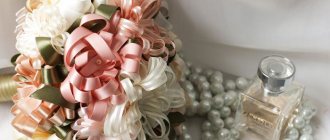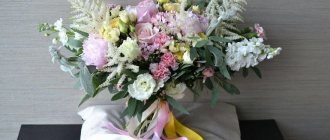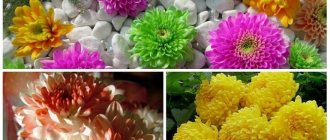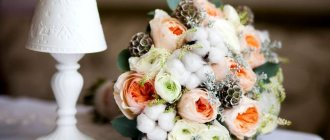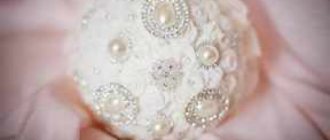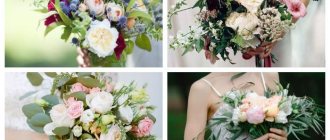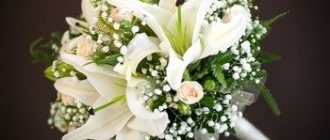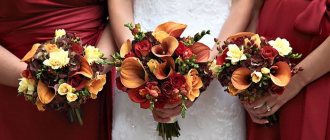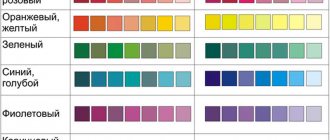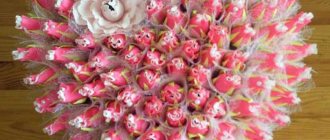Gypsophila is a miniature plant that has always been perceived as filling flower arrangements. With its help, they created a background for the main colors or decorated them. And only in recent years have florists begun to make mono-bouquets from gypsophila. It turned out that they turn out surprisingly tender and charming. We are receiving more and more orders for these cute flowers. Therefore, it’s time to tell you what gypsophila means in ordinary and wedding bouquets, as well as to whom and for what occasion it can be given.
What does the flower symbolize?
A bridal bouquet made from gypsophila is light and airy. The plant is popularly called “tumbleweed.” In Germany it was called the “bridal veil”.
Thanks to its delicate appearance, gypsophila has become associated with weightlessness, lightness, purity and sincerity. It’s not for nothing that another nickname for gypsophila is “baby’s breath.”
The plant symbolizes eternal love. In some cultures - frivolity. Paying attention to the symbolism of the accessory, it is worth remembering that each flower means a special feeling, mood or character. So, if you make a wedding bouquet of roses and gypsophila, the symbolic meaning will also change.
The choice of colors also matters. Pastel is closer to tender expressions of feelings, bright colors mean extravagance and passion.
Interesting! Gypsum lyubka is an unusually resistant plant. Maintains appearance in winter compositions. Dried flowers are used to create ikebana.
Symbolism
Like every flower, gypsophila has its own meaning. Its delicate flowers, fragile branches and thin graceful leaves can only be associated with innocence and purity: both physical and spiritual. Symbolizing virginity and inexperience, the flower also shows some frivolity of the young bride walking to the altar. It’s not for nothing that gypsophila is called the “bride’s veil” - it really, like a light cloud, accompanies a girl who is just entering adulthood in her life, uniting forever with her chosen one. Its white color harmonizes perfectly with the snow-white dress.
Important! This lovely light flower does not need to be accompanied by heavy scarlet roses or coldly solemn chrysanthemums. Even alone they are able to create a light, incredibly airy holiday atmosphere
Due to such a vivid interpretation of the symbolic meaning of gypsophila, it is not recommended for mature brides or those who are remarrying. For sophisticated ladies, there are luxurious, fragrant, beautiful flowers, and girlish modesty does not quite suit them.
Another symbol personified by gypsophila is not courage, but timidity. The young girl is pure and timid, like an angel descended from heaven. The discreet beauty of wonderful flowers on fragile stems with one stroke of the pen will describe the noble virtues of a beauty who, not without trepidation, entrusts her destiny to her chosen one.
What compositions are made?
Gypsophila is an inexpensive and accessible flower. Widely used in wedding decoration. It is used to decorate flower arrangements for a banquet hall, gypsophila is used to make topiaries, and is included in wedding wreaths.
It can be included in the bride’s hairstyle and the groom’s boutonniere, and mono-bouquets can be distributed to the bridesmaids.
Florists love gypsophila for its modest appearance. It is happily added to compositions of large double flowers so that they do not look heavy.
Gypsophila is most often an addition to a bouquet. But the latest trends in wedding fashion have brought gypsophila to the forefront.
In addition to white gypsophila, there is also a pink type of flowers. They are less common. Grown for cutting. Pink gypsum, like white, is rarely included in mono-bouquets, usually combined with other flowers.
Interesting! Another interesting and beautiful option for a wedding composition is a wedding bouquet of succulents.
Varieties
The most famous version of a flower arrangement with gypsophila is a pink accessory.
- A composition of pink or cream roses is suitable for a classic wedding and emphasizes the tenderness of the bride. It is decorated with lace.
- A green accessory with succulents and baby blue eucalyptus is suitable for those who do not like bright shades. It gives a feeling of calm.
- A simple but interesting bouquet - plaster of Paris with daisies. Suitable for an outdoor wedding.
- An elegant accessory is made from white carnations and lisianthus.
- For a sea wedding, gypsophila is combined with irises, white spray roses and eucalyptus parvifolia.
- A fabulous wedding bouquet of gypsophila will be created if you combine white freesias, peonies and hydrangeas, and Armango roses. Eucalyptus cineria is added to it.
- A drop bouquet in a porta bouquet looks elegant in combination with white roses, white lisianthus, decorative pins and rhinestones.
- Cascading compositions are made from orchids and gypsum. A bridal bouquet made of gypsophila, as in the photo, is suitable for a young girl.
- White closed tulip buds are framed by small tumbleweed flowers and framed by galaxy leaves.
- To express great feelings, a bride's bouquet with gypsophila can be decorated in the shape of a heart. Plaster of Paris is placed in the center and along the edges of the composition, red roses make up the inner smaller heart.
- A small bouquet of gypsophila and dried lotus flowers is combined with an Empire style dress and a Greek style bracelet.
- A mono bouquet suits a simple look. If simplicity is not your style, you can give the composition an interesting shape by creating a flowing accessory. A small mono bouquet will suit a vintage look, which definitely requires mesh gloves.
Attention! Gypsophila looks equally good in tall white vases as well as in glass and tin jars.
Crescent or crescent bouquet
This bouquet is made in the form of an arc on a frame. The middle of the bouquet is wide and voluminous, and the ends are airy and light. You can wear it by the handle, in the crook of your arm or on your wrist.
| pros | Minuses |
|
|
Who is it suitable for?
- This bouquet is suitable for both tall and thin brides and curvy girls.
- Perfect for pregnant brides.
- If we talk about the outfit, then the ideal option would be a dress of a simple cut with a floor length.
- Doesn't match with a pantsuit.
- Crescent bouquet
- Crescent bouquet
- Crescent bouquet
- Crescent bouquet
Provence
A bride's bouquet in Provence style, made in a minimalist style, usually consists of wildflowers in delicate pastel colors: lavender, daisies, bells, clover, phlox, sometimes complemented by rosebuds.
Wedding bouquet in Provence style
Celebration style
Ideal for a rustic wedding. This is a simple, close to nature, style that is at the intersection of rural and vintage weddings. The ceremony focuses on spontaneity and sincerity. There is no formality - formal suits, a classic white dress, a formal banquet hall.
Instead of black and snow-white colors, beige, milky, and flesh colors are present in the outfits. The outfits are looser, simple in style, without frills or luxury. The groom does not have to wear a three-piece; it can be replaced with a sand-colored vest. You can do without it altogether, and wear only a shirt and trousers with suspenders. Striped socks add spontaneity to the action.
Florists create three-dimensional compositions from gypsophila that look like clouds. It is used to decorate the backs of chairs, wedding arches and swings for photo shoots. Gypsophila goes perfectly with natural materials, especially wood, linen, and burlap.
Botanical certificate
The plant has several names. The international classification uses the Latin designation Gypsophila - “loving gypsum”, which is associated with soil preferences. Under natural conditions, the plant chooses clayey areas with a high lime content. The second name of the popular herbaceous perennial is kachim. It belongs to the Carnation family.
The natural habitat of the cachima covers the southern regions of Europe, in particular the Mediterranean, East Asian countries and Australia. About 150 species are known belonging to the genus Gypsophila. All of them are distinguished by a highly branched stem, lanceolate leaves collected in a basal rosette and small flowers, reminiscent of a carnation in structure. The petals can be greenish, snow-white, or pink.
Kachim has been successfully cultivated by gardeners for a long time. The leaders in this area are considered to be the planters of Ecuador, who supply the market with very beautiful, double varieties with large inflorescences densely sitting on the branch. Dutch producers, thanks to special watering technologies, produce flowers in unnatural shades: green, blue, lilac, purple and others, which are also in demand among florists.
Master class: DIY accessory
A creative and at the same time budget bouquet of gypsophila can be assembled with your own hands from available materials.
You will need:
- birch or willow branches;
- carnation;
- bush and monophonic rose;
- Eucalyptus populus;
- gypsophila.
The composition will require a minimum of flowers. The gypsophila in this bouquet is unusual - painted silver (a spray can is suitable for this purpose).
- A white rose is placed in the center of the composition. The nest is through, so the stem extends beyond the border of the weaving. The rose is decorated with eucalyptus leaves.
- Next to the rose is a bright pink carnation and a soft pink spray rose.
- The space needs to be filled with greenery again. Eucalyptus populus towers above the buds. The flowers themselves are placed on the same level.
- Silver sprigs of gypsophila are added.
- At the end, 2 more white roses and 2 carnations are added.
- The stems are trimmed to the same level.
A wedding bouquet with gypsophila is assembled very quickly - in 3-5 minutes. The most difficult thing about it is making the nest.
This accessory is suitable for both summer and winter weddings. For a celebration in the cold season, you can create a themed bouquet covered with artificial snow.
Gypsophila is a versatile plant. On the one hand, it is simple, and on the other, elegant and airy. It is used to make classic and original bouquets. It goes with almost any outfit, even the most elaborate one.
admin 115
Previous article
Do you need engraving on wedding rings - examples of inscriptions
Next article
How to choose a bouquet of gypsophila?
Despite the apparent simplicity of the plant itself, it is quite difficult to create an interesting composition from it. The complexity lies precisely in that very simplicity. It will not be enough to take a couple of twigs. I would like to dilute the image with more interesting and original details.
First of all, before choosing a bouquet, newlyweds look at the style of their own wedding celebration. Fortunately, the plant is ideal for many events. It will fit especially beautifully into a rustic themed and simplest wedding. It can be rustic or boho style. The only condition will be a special theme party. For example, if you have a stylish celebration in a nautical style, then gypsophila will be inappropriate.
It is worth relying on the image of the bride. If the girl is tall and sophisticated, then a few simple plant branches will help her emphasize her image. If the young lady has a fluffy dress and the figure itself is appropriate, then the shape of the composition should be round or hemispherical.
Gypsophila will look more elegant if you add decorative elements to it. They can be satin ribbons, simple twigs, wood and even burlap. It goes well with many decorative pieces.
If you want to surprise your guests, you can always use a bouquet of pink gypsophila. They are much less common than white ones, so you should order them in advance in order to have time to purchase them for your own celebration.

